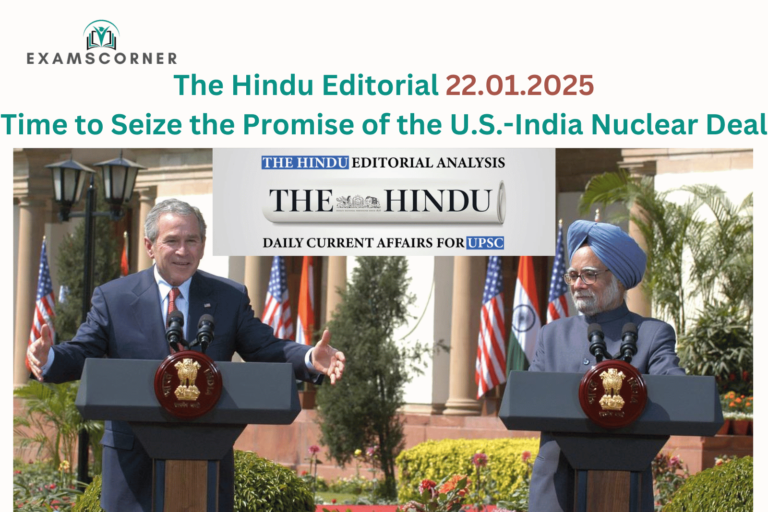The U.S.-India civil nuclear deal, a landmark agreement heralded as a game-changer, continues to face significant hurdles that have prevented its full realization. Sixteen years after its final approval in the U.S. Congress, it is evident that focused efforts are needed to overcome challenges and unlock the deal’s transformative potential. This article examines the history, significance, and path forward for this monumental partnership.
A Historic Breakthrough
In 2008, the U.S.-India civil nuclear deal marked the culmination of years of lobbying and collaboration between the U.S. administration, Congressional leaders, and the Coalition for Partnership with India—a diverse group of businesses, Indian-Americans, and academics. This coalition’s efforts were pivotal in overcoming fierce opposition to the deal, which critics argued would promote nuclear weapons proliferation.
The agreement was celebrated as a watershed moment in U.S.-India relations, signaling the end of Cold War-era estrangement and ushering in a new era of defense and strategic cooperation. By fostering trust through nuclear technology collaboration, the deal laid the groundwork for broader partnerships in defense purchases, military exercises, technology transfer, intelligence sharing, and crisis management.
The Vision of the Deal
The U.S.-India nuclear deal was envisioned to revolutionize India’s civil nuclear sector. It promised:
- Access to U.S. technology, equipment, and services.
- The construction of new nuclear plants to meet India’s growing energy needs.
- Job creation in both countries.
- A reduction in India’s reliance on fossil fuels, thus contributing to environmental sustainability.
Despite these lofty goals, several obstacles have stalled progress, leaving projects such as the proposed six Westinghouse nuclear plants announced in 2016 unfulfilled.
Recent Developments and Challenges
Regulatory Barriers
During a recent visit to India, Jake Sullivan, U.S. President Joe Biden’s National Security Adviser, announced efforts to address regulatory hurdles obstructing U.S.-India civil nuclear cooperation. Historically, these barriers included the inclusion of nearly 200 Indian entities on the U.S. “Entity List,” which restricted business engagements. While the 2008 deal led to the removal of most entities from this list, a few remain due to concerns about technology leakage and security risks.
Dual-Use Technology Concerns
Concerns over dual-use technologies—those with both civilian and military applications—have hindered collaboration. Sullivan highlighted the importance of aligning U.S. and Indian export control systems to prevent technology diversion to adversaries. While the Biden administration has reassessed the security risks posed by remaining Indian entities on the Entity List, consensus among U.S. security and foreign policy agencies remains uncertain.
Liability Risks: The Gordian Knot
India’s Civil Liability for Nuclear Damage Act
India’s 2010 Civil Liability for Nuclear Damage Act is a significant impediment. Unlike international norms, which place liability primarily on facility operators, the Indian law assigns liability to suppliers. This has deterred major U.S. suppliers, including GE and Westinghouse, from participating in India’s nuclear expansion.
Attempts at Amelioration
The Indian government has attempted to mitigate supplier liability through an insurance framework led by the General Insurance Corporation and other public sector entities. This initiative offers a 20-year insurance premium to cover supplier liability. While Russia’s state-owned nuclear companies have accepted these terms, U.S. private companies remain hesitant, lacking the sovereign immunity protections that Russian firms enjoy.
Technological and Financial Hurdles
Evolving Technology
Civil nuclear technology has advanced significantly since 2008. U.S. companies must demonstrate that their offerings are both cutting-edge and cost-effective to compete with global suppliers.
Cost Concerns
Indian officials are wary of cost overruns, which have plagued recent U.S. nuclear projects and burdened ratepayers without delivering proportional benefits. U.S. suppliers must address affordability to make their technology attractive to Indian consumers.
The Path Forward
To realize the full potential of the U.S.-India nuclear deal, a collaborative approach is essential. Key steps include:
- Resolving Liability Issues: The U.S. government can work with Indian authorities to establish mutually acceptable liability frameworks.
- Advancing Regulatory Alignment: Streamlining export control systems and addressing dual-use technology concerns are critical.
- Promoting Technological and Financial Viability: U.S. companies must offer competitive, reliable, and affordable solutions.
- Strategic Engagement: Leveraging the geopolitical significance of U.S.-India cooperation to garner broader support for nuclear collaboration.
Conclusion
The U.S.-India civil nuclear deal holds immense promise for energy security, economic growth, and strategic partnership. While challenges persist, they are not insurmountable. By addressing liability concerns, regulatory barriers, and cost issues, the U.S. and India can unlock the transformative potential of this agreement. The time to act is now, as the benefits of a fully realized U.S.-India nuclear partnership would be profound for both nations and the global community.



